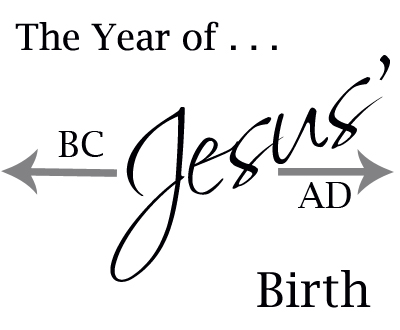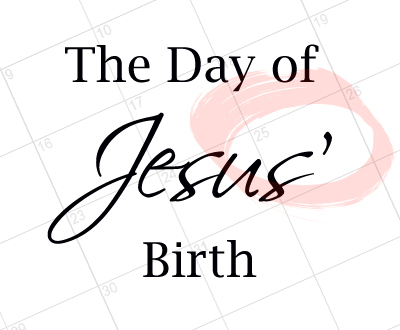The Year of Jesus’ Birth
The year of Christ’s birth may seem obvious, since modern calendars note the years before his birth as BC (Before Christ) and the years after his birth as AD (Anno Domini, Latin for the “Year of the Lord”). Yet, Christ’s birth did not fall perfectly between the two. A short review of how modern calendars were created will help to shed light on this surprising fact.

By the sixth century, there was a rapidly growing Christian population throughout the Western world. The existing Julian calendar was intimately tied to the pagan Roman Empire and counted its years in terms of Anno Urbis Conditae, Latin for “The Year of the Foundation of the City” (meaning Rome in 753 BC). Since the Roman Empire had collapsed in the fifth century, the Church recognized the need for a new calendar. A Scythian monk named Dionysius Exiguus was called to the task in 525 AD. Though Dionysius kept many of the Roman calendar elements in place (like days of the week and months of the year),* he made a critical change to the way years were counted. Scholar Mark Kidger explains the process:
“To set his calendar apart from its Roman predecessor, Dionysius decided to base it on the date of the birth of Jesus. . . . First, though, he had to calculate for himself the date of the Nativity. To do this, he followed precedent and used one of the best and most reliable measurements of time available to him: the reigns of the Roman emperors. By summing up the lengths of their reigns and calculating backwards, he was able to fix the date of the birth of Jesus by what appeared to be a most satisfactory method.”1
Unfortunately, Dionysius made a few mistakes in his calculations. First, he forgot to account for the year zero; his calendar jumped from 1 BC to 1 AD. Second, Dionysius “excluded a four-year period during which Caesar Augustus reigned under his given name of Octavian, which he used for only a short part of his reign.”2 These two mistakes added up to a total of five years. According to Kidger, “If we assume that Dionysius made no other mistakes, Jesus would have been born in 5 BC — paradoxically, five years ‘Before Christ.’”3
Additionally, historical records date King Herod’s death shortly after an eclipse of the Moon, which was visible from Jericho, and before the feast of Passover (likely late March or early April in 4 BC). Herod was very much alive when Christ was born, making it unlikely that Jesus was born after 4 BC.
The arguments for an even earlier date for Christ’s birth mainly center on the date of the census decreed by Caesar Augustus for which Mary and Joseph traveled to Bethlehem. History reveals three different decrees by Caesar Augustus for a census: one in 28 BC, another in 8 BC, and yet another in 14 AD. It is reasonable to imagine that Ceasar’s decree for a census in 8 BC could have taken three years to implement. Thus, the actual census could have taken place in 5 BC.4
In summary, it seems ironic that our modern calendar erroneously dated Christ’s birth (the very date for which it was designed). Regardless, the intention of the Church was clear — to identify the birth of Christ as a turning point in history, the beginning of the Church Age. And despite the pagan remnants of our calendar (see end notes regarding the days and months of the year), the God who transcends time entered human history to redeem time itself. Jesus’ birth into the world initiated a Christian calendar in which every year begins with the Christmas season.
This page was created by:

Back to main Christmas History page.
We welcome your ideas! If you have suggestions on how to improve this page, please contact us.
Information on this page was drawn from our featured Christmas book. You may freely use this content if you cite the source and/or link back to this page.
FOOTNOTES:
1 Kidger, Mark. Star of Bethlehem. Princeton University Press, 1999, p. 44.
2 Kidger, Mark. Star of Bethlehem. Princeton University Press, 1999, p. 45.
3 Kidger, Mark. Star of Bethlehem. Princeton University Press, 1999, p. 45.
4 Maier, Paul. In the Fullness of Time. Kregel Publications, 1997, p. 8.
*DAYS OF THE WEEK: Though the concept of a seven day week has its origin in the creation account, the names of each day are rooted in various pagan beliefs. The following is an excerpt from Encyclopedia Britannica: “The days assigned by the Romans to the Sun, Moon, and Saturn were retained for the corresponding days of the week in English (Sunday, Monday, and Saturday) and several related languages. The other weekday names in English are derived from Anglo-Saxon words for the gods of Teutonic mythology. Tuesday comes from Tiu, or Tiw, the Anglo-Saxon name for Tyr, the Norse god of war. Tyr was one of the sons of Odin, or Woden, the supreme deity after whom Wednesday was named. Similarly, Thursday originates from Thor’s-day, named in honour of Thor, the god of thunder. Friday was derived from Frigg’s-day, Frigg, the wife of Odin, representing love and beauty, in Norse mythology.” Information for days of the week was drawn from: Encyclopedia Britannica. “Week.” Retrieved August 17, 2008 from Encyclopædia Britannica Online: http://www.britannica.com/EBchecked/topic/638786/week.
MONTHS OF THE YEAR: The months of the year also have roots in paganism. The following information is drawn from Mark Kidger: January gets its name from Janus, the two-headed god of gates who looked forward and backward at the same time. February is named after the Roman feast of Purification, Februa. March is named after the god Mars. April gets its name from a Latin word, apero, meaning “the latter” or “second” (March was actually considered the first month of the Roman year, so April would have been the second). May is named after Maia, the Goddess of increase. June is named after Juno, the sister of Jupiter. July is named after Julius Caesar. August is named after Augustus Caesar. The remaining months were named according to their position in the Roman calendar: September (the seventh month), October (the eighth month), November (the ninth month), and December (the tenth month). Information for months of the year was drawn from: Kidger, Mark. Star of Bethlehem. Princeton University Press, 1999, pp. 40-41.





